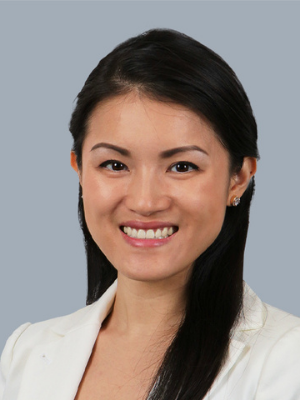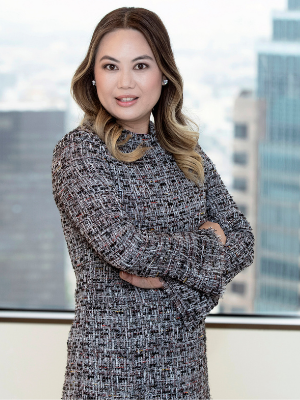 “I’m a diver,” says Ashley Shan, a fourth-year associate at Shearman & Sterling LLP’s New York office. “If I’m new to a place, I want to jump in and learn everything about it and be an active part of the community. That’s what’s driven my career, and I want to bring that opportunity to others.”
“I’m a diver,” says Ashley Shan, a fourth-year associate at Shearman & Sterling LLP’s New York office. “If I’m new to a place, I want to jump in and learn everything about it and be an active part of the community. That’s what’s driven my career, and I want to bring that opportunity to others.”
Reflecting on her past three years at Shearman, Ashley speaks to the value of building relationships, supporting diverse lawyers and taking the initiative to make things happen.
From Philosophy to Finance
Realizing her B.A. in philosophy and sociology from Vanderbilt wasn’t going to adequately prepare her for modern legal practice, Ashley took advantage of everything Duke Law had to offer to broaden her experiences. She enrolled in the JD/LLM dual-degree program at Duke, which took her to an internship in Tokyo and a summer school in Geneva. “I was a research assistant, a teaching assistant and a senior editor on law review; I took a legal clinic, a practicum course at the business school, and an externship at the Environmental Defense Fund. I had friends from the business school, med school, public policy school and the environmental school.” She continues being active within the Duke NY community.
She encountered Shearman during 1L at a presentation on navigating the on-campus interview process while attending a diversity summit for Asian law students. She stayed in touch with the recruiting team and met other Shearman attorneys, who generously shared their experiences and mentored her. She also spent the rest of 1L reaching out to connections and getting to know other law firms, but the people she met from Shearman made the post-OCI decision simple: she took Shearman’s offer as soon as she received the letter.
Since starting at the Finance Group in 2019, Ashley has worked on a variety of transactions representing corporate borrowers, private equity sponsors and lenders in leveraged finance, structured finance and fund finance. “In the last year, I’ve gravitated towards representing corporate and private equity clients in middle market transactions because you really get to know your clients more holistically. You build a relationship and gain insight into all aspects of their business. I’ve also had the opportunity to dig deeper into more niched topics like liability management transactions and the ins-and-outs of the UCC from working with experts at the firm.”
As a problem solver, she enjoys the variety of the practice, building relationships, and working with senior attorneys, opposing counsel and specialist groups.
Building Community and Inclusion For Asian American Lawyers
When she’s not chewing on her bread-and-butter finance work, Ashley dedicates her time to building communities for AAPI lawyers inside and outside of Shearman. She is the co-chair of Shearman’s AAPI attorneys’ inclusion network – Asian Attorneys for Community, Empowerment and Success (AACES) – as well as the Vice Chair of the Membership Committee of Asian American Bar Association of New York (AABANY).
“Building relationships and showing up for my community is something that I enjoy and that motivates me,” says Ashley.
In addition to being a community for AAPI lawyers within Shearman, AACES also connects them with the broader AAPI legal community in New York State and nationally through organizations like AABANY, South Asian Bar Association of New York (SABANY) and the National Asian Pacific American Bar Association (NAPABA). Last year, through Shearman’s sponsorship, Ashley attended her first NAPABA convention. “It was my first time being surrounded by so many successful AAPI legal professionals. I saw the different ways one’s career can unfold, regardless of where you were born and whether you had lawyers in your family. There’s no ‘right track’ for your career and not just one way of succeeding.”
Compelled by the experience, Ashley has taken steps to strengthen the AACES community. Working with the other co-chairs, she advocated for Shearman to sponsor more professional organizations, increased Shearman attorneys’ participation in external networking events such as the NAPABA convention and brought in a distinguished Shearman alum to share his experience and advice for junior lawyers.
Raising Your Hand Brings More Opportunity
Ashley observes that many new lawyers keep their heads down, do what is told and treat their jobs as a nine-to-five. “I’m not a dabbler; I’m a diver. So if I go into a deal, I want to understand everything about it,” says Ashley. “I won’t let a conversation finish without clearly understanding next steps. I want to know where things are and who is doing what to keep the ball rolling.”
She feels her proactive attitude has invited opportunities, especially at a well-known New York law firm like Shearman. “Since joining Shearman, I’ve worked on headline-worthy deals, presented multiple CLEs, attended industry events, put on my own events, recruited external speakers and sent colleagues to conferences across the nation.” She is well aware of the power of mentors and sponsors along the way. Last year, her practice group leaders nominated her to attend a virtual development program for diverse junior associates at the New York City Bar Association. She also regularly receives support from partners and senior attorneys who guide her based on where she wants to go. In her opinion, sponsorship is a two-way street: “Opportunity only lands on people who seek it. If you want to be sponsored, you need to give people an opportunity to get to know you: what you want to do, what your strengths are, and what challenges you might be facing.”
Looking back at her career, half of which was spent during the pandemic where the practice of law was anything but normal, she credited her growth to an advice from a CrossFit coach: “He told me when you are new to the gym, just be a sponge and observe everything. That’s exactly what I did when I started my career at Shearman.” She regularly encourages law students that she mentors to embrace spontaneity and explore what interests them instead of what they think their career should look like: “There’s no one way to approach being a lawyer, and you never know how each experience is going to ultimately serve you.”
Since participating in pub runs in Durham during law school, one of the craft beer capitals of the U.S., Ashley has seriously upped her running game. She’s done a couple half-marathons and she’s also now completed the nine races and volunteering efforts that guarantee her entry in the New York City 2023 Marathon. Like Ashley says, she’s a diver.







